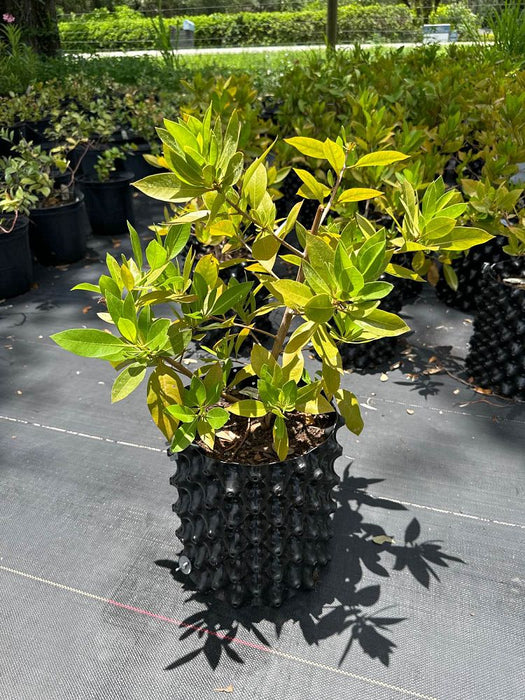
Buttonwood Green
Best Growing Environment
The Buttonwood Green (Conocarpus erectus), also known as the Green Buttonwood, is a resilient and versatile plant native to coastal areas in the southeastern United States, the Caribbean, and parts of Central and South America. This plant thrives in salty, coastal environments, making it a popular choice for seaside landscapes. It prefers well-draining sandy or loamy soils but can also tolerate clayey soils and occasional flooding. The Buttonwood Green is highly adaptable to different soil pH levels, from slightly acidic to alkaline, and can withstand both wet and dry conditions. It grows best in full sun but can also tolerate partial shade, although its growth may be slower in less light.
Common Names
The Buttonwood Green is commonly known by several names, including:
- Green Buttonwood
- Button Mangrove
- Buttonwood Mangrove
- Buttonwood Tree
Average Height and Diameter
Buttonwood Green typically grows to a height of 20 to 35 feet (6 to 11 meters), with a spread of 15 to 25 feet (4.5 to 7.5 meters) in diameter. However, in ideal conditions, it can reach up to 50 feet (15 meters) tall. The tree has a rounded, spreading canopy with dense, leathery leaves that are green to gray-green in color. The trunk is often gnarled and twisted, giving the tree a distinctive, rugged appearance. The Buttonwood Green can also be pruned and trained as a hedge or shrub, making it a versatile choice for various landscaping needs.
Growth Rate
The Buttonwood Green has a moderate growth rate, typically growing about 12 to 24 inches (30 to 60 cm) per year under optimal conditions. This rate can vary depending on factors such as soil quality, water availability, and sunlight. Regular watering and fertilization can enhance its growth rate, while poor soil or environmental stressors may slow it down.
Sun Requirements
Buttonwood Green thrives in full sun, where it receives at least 6 to 8 hours of direct sunlight daily. It can also tolerate partial shade, particularly in the hottest regions, but too much shade can result in a thinner canopy and slower growth. When planted in full sun, the tree develops a dense, bushy form, making it an excellent choice for windbreaks, privacy screens, or as a specimen tree in coastal gardens.
Cold Hardiness
Buttonwood Green is hardy in USDA zones 9b to 11, where it can withstand winter temperatures as low as 30°F to 40°F (-1°C to 4°C). It is not frost-tolerant and may suffer damage or die back if exposed to freezing temperatures for extended periods. In colder regions, it can be grown in containers and brought indoors during the winter, or used as a seasonal plant in warm weather. The plant is also salt-tolerant, making it ideal for coastal gardens where salt spray or saline soil would challenge other species.
Water Requirements
Buttonwood Green is moderately drought-tolerant once established, but it prefers regular watering, especially during the first few years after planting. Water the tree deeply and regularly to help establish a strong root system, allowing the top few inches of soil to dry out between waterings. Once established, the tree can survive on natural rainfall but will benefit from occasional deep watering during prolonged dry spells. The plant is also tolerant of occasional flooding, making it suitable for areas with fluctuating water levels or poor drainage.
Detailed Fertilizing Guide
To promote healthy growth and vibrant foliage, fertilize Buttonwood Green in early spring with a balanced, slow-release fertilizer with an N-P-K ratio of 10-10-10 or 14-14-14. Apply the fertilizer evenly around the root zone, avoiding direct contact with the trunk, and water thoroughly after application. In coastal or sandy soils, additional applications may be necessary to replenish nutrients that leach out quickly. A second application in mid-summer can support continued growth through the warmer months. Avoid over-fertilizing, as this can lead to excessive growth and increased susceptibility to pests and diseases.
Planting Guide
When planting Buttonwood Green, choose a location with full sun and well-draining soil. If planting multiple trees, space them 15 to 25 feet apart to allow for their mature spread. Dig a hole twice as wide and as deep as the root ball, and mix the removed soil with organic compost to improve soil fertility. Place the tree in the hole, ensuring the top of the root ball is level with or slightly above the surrounding soil. Backfill with the soil mixture, firming it gently around the base of the tree, and water deeply after planting. Mulching around the base with organic material can help retain moisture and regulate soil temperature, but keep the mulch a few inches away from the trunk to prevent rot.
